Kingdom of Dagbon
The Kingdom of Dagbon (Dagbaŋ) is the oldest[2][3][4] and one of the most organised traditional kingdoms in Ghana founded by the Dagomba people (Dagbamba) in the 15th century. During its rise, it comprised, at various points, the Northern, Upper West, Upper East, Savannah Region and North East regions of present-day Ghana[5]. It also covered portions of Burkina Faso, North East Ivory Coast[6] and North West Togo[7]. Since Ghana's independence in 1957, the Kingdom just like all of Ghana's kingdoms and ethnic states has assumed a traditional, customary role.[8]
Empire of Dagbon Kingdom of Dagbon Royaume de Dagbon Dagbaŋ | |
|---|---|
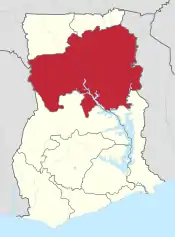 Territories of the Kingdom of Dagbon | |
_locator_map.png.webp) Region of the Kingdom of Dagbon (black rectangle) | |
| Capital | Yendi 09°26.5′N 00°0.5′W |
| Largest city | Tamale |
| Official languages | Dagbani (lingua franca), English, French, Arabic |
| Ethnic groups | Dagbamba (Dagomba) |
| Religion | Islam |
| Demonym(s) | Dagbon |
| Government | Monarchy |
| Gariba II | |
| History | |
• Founded | c. 1200s-1300s |
| Area | |
• Total | 97,702 km2 (37,723 sq mi) |
| Population | |
• 2019 estimate | 5,197,937[1] |
| HDI (2021) | 0.63 medium |
| Time zone | UTC+0 (GMT0) |
| UTC+0 (GMT0) | |
| Today part of | Ghana |
Dagbon is one of the few kingdoms in Africa where certain chieftaincy titles are reserved for women. They rule, ascend to the position of chieftaincy with male subjects, and own regal lands.[9][10][11][12] The contribution of its women is prominent as it has given birth to Ghana's first female minister,[13][14] and Africa's first female cabinet minister.[15][16] Historically, its noble daughter, Yennenga, is regarded as the "mother" of the Mossi kingdoms,[17][18][19] a people who constitute nearly half of the nation of Burkina Faso. The Gundo Naa is the head of all female chiefs, and the Zosimli Naa enhances collaboration between cities of Dagbon and sister cities.
History
Oral histories of the Kingdom tell that it was founded by Naa Gbewaa, a great grandson of a famous warrior named Tohazie[20][21]. Tohazie gave birth to Kpuɣnamba (ʒinani) and this line of successors journeyed from east of Lake Chad, stopping at several places including Zamfara, present-day northern Nigeria, and in the Mali Empire. Gbewaa would later establish Dagbon in present-day northern Ghana. Before Naa Gbewaa, Dagbon was composed of small decentralised states headed by the Tindaamba. Gbewaa unified the states. Unlike his successors who were migratory, he established a stable kingdom. His reign was marked by stability, wisdom, benevolence, and longevity. These histories tell of numerous engagements with neighbouring peoples throughout this early period until the early 18th century, when the capital of the kingdom was moved to the city of Yendi. Islam arrived to the kingdom in the 1600s after Naa Zangina adopted it,[22] and a period of peace and increased trade with neighbouring kingdoms began.
In the late 19th century, Dagbon was threatened at all angles. The Germans were expanding from the East, the British from the South, and the French from the North and East. The Germans invaded Dagbon in 1896. After the German invasion of Eastern Dagbon at the Battle of Adibo, Eastern Dagbon fell to the Germans. The centuries old Gbewaa Palace was burnt. Eastern Dagbon became part of German Togoland and Western Dagbon became part of the British Gold Coast. Western Dagbon was a protectorate and not a colony. The British presence prevented further German attacks into Western Dagbon. Following World War I, eastern Dagbon became part of British Togoland. The Gold Coast achieved independence in 1957 and became Ghana. The result of interference of British and German imperialism was a kingdom that was significantly robbed of its once invaluable traditional artifacts, beautiful way of life and a divided Kingdom whose wounds would not completely heal till the second decade of the 21st Century.
The division of Dagbon by the Germans and British without regard to the peoples history brought several challenges, mainly in its traditional leadership. The Kingdom since around the 1920s has been characterised by repeated succession disputes and conflict mainly from British and German Imperial interference in Dagbon's succession. Several incidents have occurred, including in 2002 when the King of Dagbon Yakubu Andani II, of the Andani royal family, was murdered by the unknown people.[23] As of January 2014, a regent (installed in 2006) has acted as sovereign of the kingdom until a new ruler is chosen.[24] Today, the king of Dagbon's court remains at the city of Yendi. The kingdom is divided into territorial chiefdoms, categorised from divisional to village chieftaincies. The monarch of Dagbon is known as the Yaa Naa (also spelt Ya Na, Ya-Na, Ya Naa Yaan Naa).
On 18 January 2019, a new Yaa Naa, Abubakari Mahama [Naa Gariba II], was chosen in Yendi by the Dagbon state's kingmakers. This was after a peace initiative by the Committee of Eminent Chiefs, consisting of the Yaa Naa brother the Na Yiri, the Asante chief and the Yagbonwura. He was enskinned on 26 January 2019 in Yendi.[25] The Yaa Naa and the Na Yiri are sons of Gbewaa and mediate issues in each other kingdoms from time to time.
The Lunsi play a role in preserving Dagbon oral history.[26] The Lunsi of Dagbon constitutes a venerable guild of specialists charged with the solemn duty of preserving historical and genealogical information, duly arranged in accordance with the succession of chiefs and noble lineages.[27] Later history is better known, because, in addition to court historians, there are other sources of information, some of them independent of events in Dagbon itself.[28]
Pre-Gbewaa Period
Archaeological evidence suggest that there were thriving civilisation in Dagbon before the neolithic period. There is evidence of agricultural acitivities and iron industries during the neolithic period. The people who lived during this period, the aboriginal Dagombas, are known locally as Dagbon Sablisi. During this period, Dagbon was a decentralised society. It was made of Tinsi(towns) which were headed by Tindaanima (singular: tindana). The Tindaanima mainly oversaw spiritual and religious activities. They undertook the pacification of the tingbana (earth gods), bina (gods), and buga(idols). Even today, each town has a tindana who still oversee this religious activities. Festivals like the Bugum Chugu can be traced back to this era. Similarly musical instrunments like the Gungong and dances like the Zhem are all from this period
Arrival of Naa Gbewaa and Centralisation of the States
Naa Gbewaa arrived and settled at Pusiga, in the present day Upper East Region of Ghana. He fathered the following children[29][30]
- Naa Ʒirli (Zirile), eldest son of Naa Gbewaa
- Fɔɣu, preferred successor of Naa Gbewaa
- Naa Shitɔbu, father of Yaa Naa Nyagse
- Mamprugulana Tohigu, founded Gmamprugu
- Bimbila-Naa Ŋmantambu, founded Nanung
- Salagalana Kayilkuna, ruled over Salaga
- Kuɣa-Naa Subee Kpɛma
- Karaga-Naa Beemoni, ruled over Karaga
- Sunson-Naa Buɣyilgu, ruled over Sunsong
- Sanglana Subee Bila, ruled over Sang, in Eastern Dagbon
- Nyensung Yaambana
- Savelugu-Naa Yenyoo, ruled over Savelugu
- Nanton-Naa Baatanga, ruled over Nanton
- Yamolkaragalana Kayetuli, ruled over Yemokaraga
- Bohinsan Zugulana
- Zantanlana Yirigitundi, ruled over Zantaani in Western Dagbon, now under Tolon District
- Zoggolana Sungburi, ruled over Zoggu
- Nyingaa Ʒibie
- Kpuɣli Kungoo
- Gundo-Naa Kachaɣu, eldest daughter, became the first Gundo Naa. The Gundo Naa title is reserved for only females.
- Yaantuuri (Yennenga), beloved daughter, travelled northward and married Rialle. Their son, Ouedraogo founded the Mossi Kingdoms.
Naa Gbewaa lineage traces back to Tohazhie, the Red (fair-skinned) Hunter. These histories narrate the story of Tohazhie, who left Tunga, east of Lake Chad, with a small band of cavalry men into Zamfara, present-day Nigeria, before moving on to Mali. Tohazhie married the daughter of the king of Mali, Pag Wabiga, and fathered a son, Kpoginumbo(Ʒinani).[31]: 25
After serving briefly in Mali, Kpogonumbo and his followers came into conflict with the rising Songhay Empire in western Africa, and reprisal attacks from the Songhay forced Kpogonumbo and his followers southward. Kpogonumbo then seized power and ruled over Biun in Gurma. His son, Naa Gbewaa (or Bawa), left Biun with some of his followers to settle at Pusiga in the northeastern corner of Ghana, where he ruled until he became blind. His grave is currently located at Pusiga in the Upper East Region. Naa Gbewaa's son, Zirili, succeeded him, but succession disputes between three of Zirili's younger brothers–Tohagu, Shitobu and Gmantambo–each of them travelled outward eventually expanding the borders of the Dagbon Kingdoms. Naa Gbewaa remains in the histories of the kingdoms of Dagbon and the kingdoms of the Mamprugu and Nanumba, as their first king, founding their ruling dynasties through these sons.[31]: 25
Naa Gbewaa's children led by his son Shitobu settled briefly at the town of Gambaga before moving south to Namburugu, near Karaga, where he founded the Dagbon state. The king became known as Yaa Naa, meaning "king of strength". As Sitobu moved south, he encountered groups of indigenous peoples. such as the Konkomba, Nafeba, Basare and Chamba, who did not have centralised political structures, except for the office of the tengdana or tindana–the earth priest, literally translated as "owner of the land". The tengdana presided over ritual ceremonies and acted as a mediator between the people and the gods of the land.[31]: 25
Sitobu's son, Naa Nyagsi (r. 1416–1432) succeeded him and embarked on a war of expansion, killing many of the tengdana and holding sway over the indigenous people. Naa Nyagsi established his capital at Yani Dabari, located in the area of Diyali, near Tamale, and developed a stable political organisation by installing his sons, brothers and uncles as rulers over the conquered people. The surviving tengdamba continued to function as earth priests, while some members of the Konkomba were assigned roles in the military.[31]: 25
Relocation of Capital
The capital of Dagbon was relocated from Yani Dabari (Ruins of Yani) to current Yani (Yendi) in the east because of the invasion of the Gonja people. Gonja attacks in Western Dagbon (Tomo), especially at Daboya dealt a lot of damage to the Dagomba people. Naa Luro, though victorious over the Gonja in a later battle, could not stand the sustained warfare and relocated the capital to Yendi. The Gonja followed eastward Naa Zanjina finally halted the Gonja attacks when he decisively defeated them and killed their chief, Kumpatia, at Sang near Yendi.[31]: 25
Naa Zanjina not only is reputed to be the first Muslim ruler of the Dagbon, but is also credited with encouraging trade. With the relocation of the capital to Yendi and the return of peace, a Muslim community emerged at the Yaa Naa's palace at Yendi. The Dyula, of Mande origin, led by Sabali-Yarna, and the Hausa Muslims, led by the Kamshe Naa, bolstered Islamic influence in the kingdom. Beginning with the Sabali-Yarna, and later the Kamshe Naa, these people became responsible for the Yaa Naa's protective prayers. At the Yaa Naa's palace, Muslim titles, a sign of the integration of Muslim elders into the political structure, included the Walgu Naa, who made sure that the Yaa Naa had his portion to "Drink the Qur'an"; the Nayil Liman, the imam of the Yaa Naa, and the Yidan Kambala, were also credited with the imamship.[31]: 25–26
The extension of trade with the Dyula, and later with the Hausa, linked the Dagbon state with neighbouring kingdoms, like the Fezzan, Egypt, and the Bight of Benin. By 1788, Yendi was said to be bigger than Kumasi and Salaga.[31]: 26
It was culturally closer to, and was the result of, other Sahelian kingdoms, especially to the Mossi Kingdoms, Mali Empire, Songhai Empire, and Hausa Bakwai, with which Dagbon were major trading partners for salt, kola nuts, and slaves.
Kingdoms and States that originated from Dagbon
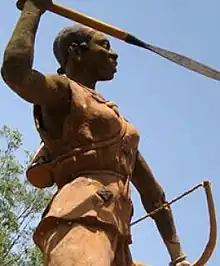
.jpg.webp)
When Naa Gbewaa died, many subkingdoms will arise including Mamprugu and Nanung. Whiles Gbewaa was still alive, his daughter Yennenga,[32][33][34] travelled north and founded the Mossi Kingdoms of Ouagadougou(Dagbani: Waɣaduɣu), Tenkodogo (Dagbani: Tingkurgu) Yatenga (Dagbani: Yatiŋa), and Fada N'Grumah, who constitute the majority of present day Burkina Faso. Other kingdoms that emerged from Dagbon include the Bouna Kingdom[35] of Ivory Coast, and the Dagaaba states[36] of the Upper West Region of Ghana.
Royal Houses
There are two main houses among the royals of Dagbon. These are the House of Abudu and the House of Andani. The royals of Dagbon are skilled in statecraft, lobbying and royal politics. The current Yaa Naa is a member of the House of Andani and the leader of his military wing the Tolon Naa is from the Abudu House. Royals in Dagbon compete intensely for chieftaincy titles but work collaboratively after ascensions.
Historical Educational and Knowledge Systems
Writing System
Dagbon scholars used a modified Arabic script, the Dagbanli Script, in its communication. Dr. Phllis Ferguson describes it as lexically Arabic, but syntactically Dagbani.[37] Much of this writing system has been lost due European colonisation. Archives and manuscripts that were housed in Moliyili were burn during the German Invasion and Loot of Dagbon.[38] Significant amout of this archives were transported to Denmark in the twentieth century.[37] Today, Dagbon uses an English derived writing system.
Scholarly Families
There were several scholarly clans in ancient Dagbon, some of them are now lost to time. A prominent family was Moliyili,[39][40] House of Moli/Mole. Moliyili had support and substantial material resources for their intellectual endeavours from Yaa Naa, the King of Dagbon. The Mole were granted a degree of administrative and legal independence and protection from external interference.[37] They thrived due to robust economic and political backing, which enabled them to engage in continuous intellectual pursuits.
The diverse range of topics covered in their manuscripts, spanning chronicles, biographies, jurisprudence, pilgrimage guides, Arabic linguistics, and Qur'anic commentaries, mirrors their status as a semi-autonomous intellectual and spiritual elite.[37] Notably, certain writings took on a scientific and technological character, such as works related to agriculture, medicine, pharmacology, and metallurgy.[37] These writings not only underscore their independent economic standing but also illustrate that Mole learning was intricately linked to various societal activities, organizations, and institutions.
The Lunsi

The Lunsi of Dagbon form a scholarly family with a unique responsibility of the preservation of historical and genealogical knowledge structured around the lineage of chiefs and royal families.[41][42][43] The head of the Lunsi is the Namo Naa[44].Their method of historical preservation involves the recitation and rhythmic drumming of proverbs, each laden with references to the history of the Dagbon royalty and their achievements.[45] Through this oral tradition, the Lunsi not only safeguard the historical legacy of their people but also serve as the storytellers who continually reaffirm the profound connection between the citizens and their revered royal ancestors.[46]
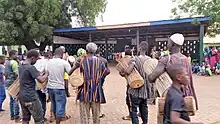
Dagbon as a British and German Protectorate (1896–1957)
Dagbon resisted colonisation as it had a well organised and powerful army. It was a protectorate, not a colony, allowing chiefs in the Kingdom to have independence other chiefs in Southern Ghana did not have. In 1888, Dagbon became part of a neutral zone, stretching from Yeji to Yendi, that was established to forestall conflict between the Germans and the British. Dagbon had to fight the Germans to the East, resist the British to the West and South, and the French were to the North. The Germans failed to capture Dagbon after multiple attempts. After the Battle of Adibo, Yendi, the capital of Dagbon was deserted. The Gbewaa Palace was burnt and Eastern Dagbon came under German control. Western Dagbon ultimately came under British control. Yendi, where the Yaa Naa resided, came under German control, separating the Yaa Naa from his people in the west.
First German expedition in 1896

From the point of view of German colonialists, the influential Yaan Naa Andani II had disturbed the trade route from the coast to Sansanné-Mangu, a German colonial station in the hinterland. Naa Andani, however, had already told German colonial administrator Hans Gruner beforehand that he believed that “it is the white man who makes the roads unsafe”.[47]
In 1896, the Germans led by Valentin von Massow, Hans Gruner and Gaston Thierry clashed with the Dagomba at the Battle of Adibo, destroyed Yendi and made away with valuables. It was a massacre, as the 7,000-man, poorly equipped Dagomba army merely rushed with their bows and arrows at the 100-man well-armed German army.[48] In 1899 the British and the Germans split Dagbon between German Togoland and the Gold Coast.[48]
Second German expedition in 1900
After the death of Yaa Na Andani II in August 1899, disputes over succession to the Dagbon throne were ongoing: Andani's eldest son aspired to become Na of Savelugu and had asked the Dagomba elders to promote the current Savelugu Na to supreme Yaa Naa. However, this suggestion was met with disagreement from Alasan, Na of Karaga, who claimed the throne for himself. German colonial governor August Köhler himself supported Alasan's claim and, in late March 1900, called for a military expedition who was then led by the colonial administrator in Sansanné-Mangu, Friedrich Rigler.[49] The latter led his troops to Yendi on 5 April 1900 but found the town deserted.[50] Meanwhile, Na Andani's eldest son Idi had moved with his retinue to Sang in the Gold Coast colony and gathered up with those who had fled Yendi.[51] These Dagomba thought they were protected from the Germans, but Rigler still attacked them in British territory on 7 April.[52] The German troops killed at least 83 people in the battle, including Andani's son.[53] After coming back to Yendi, Rigler appointed Alasan as the new Yaa Naa of Dagbon.
British colonial rule
Following World War I, eastern Dagbon became part of the British-administered mandated territories established by the League of Nations and reunited with the west, allowing the Yaa Naa to resume control of his people.: 26 The British implemented indirect rule, in which Dagomba chiefs administered local government. The British largely neglected the economic development of Dagbon. To pay the head tax the British imposed, Dagomba had to migrate to the southern Gold Coast to work in mines and on cocoa plantations.[48] The Kingdom of Dagbon enjoyed a distinct constitutional position before it became part of the British Togoland.[54][55]
Recent history
Today, the Yaa Naa's court remains at Yendi. The kingdom is divided into territorial chiefdoms, categorised from divisional to village chieftaincies. Certain chieftaincies, such as Karaga, Savalugu and Mion, are reserved for the sons of the former Yaa Naa, and their occupancy qualifies one to test for the Namship, or head chiefdom, at Yendi. Lesser chieftaincies are reserved for grandsons. Succession to the Nam has always rotated among the three royal houses, now reduced to two–the Andani and the Abudu.[56]
Over the past century, the Dagomba have faced repeated succession disputes. Following the death of Yaa-Na Mahama II in 1954, a succession dispute arose and the federal government sent troops to Yendi and intervened.
In March 2002, Ya Naa Yakubu Andani II, from the Andani House, was murdered together with forty-two of his elders in a war by supporters of the Abudu House.[23][57][58] After eight years, on 10 April 2010, around thirty to forty people were arrested for the murder in Yendi and parts of Accra in preparation for prosecution.[56][59]
On 16 November 2018, a Mediation Committee that consisted of three Eminent Chiefs finalized its plan to resolve the conflict in Dagbon. The two Houses agreed to the Committees proposal that the Abudu Royal family perform the funeral rites of the late Yaa Naa Mahamadu Abdulai from 14 to 28 of December 2018. Next was to be the funeral of the late Yaa Naa Yakubu Andani II, from 4–19 January 2019. Both obsequies took place at the old Gbewaa Palace in Yendi.[60]
Military
The Sapashina are the military of the Kingdom[61] They are divided to several units. Their dance is the Kanbon Waa.The Yaa Naa is the commander-in-chief of the Dagbon forces. The Tolon Naa is the head of the military, together with the Kumbungu Naa and the Diare Lana.
Tourism in Dagbon
Tourist sites in and around Dagbon
- Gbewaa Palace
- Cemetry of German Invaders at Adibo
- Naa Dataa Tua, at Yani (Yendi)
- Kpiljini Mystic Tree
- Stones of Tambo, Sang
- Great Hollow Baobab Tree at Kamsheɣu
- Yani Dabari (Ruins of Old Yendi)
- Tomb of Shitobu at Bagli, Near Karaga
- Saakpulgu slave site
- Grave of Babatu
- Chirzang Hills and Rock Formations
- Mole National Park
- Naa Gbewaa Tomb at Pusiga
- Savanna Centre for Contemporary Art
- Red Clay Studios
- Hamat Shea Butter Village
- Larabanga Mosque and mystic stone
- Gambaga Enscarpment
- White Volta Rapids
Dance
Dance is called Waa in the Dagbani language. Dancing is an important part of the culture of Dagbon. There are several types of dances performed individually or in groups[62][63].
Tora
Tora is performed by women of Dagbon. It is one of the oldest dance in the kingdom. It involve to-and-from rhythmic movement and subsequent buttock collisions.
Simpa
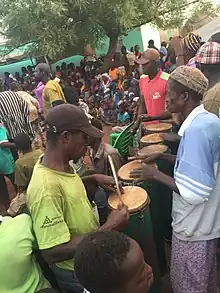
The simpa is typically performed at weddings and other celebrations, and is known for its energetic, rhythmic movements and fast tempo. The dance is usually performed by a female group and a male lead, with participants forming a circle and performing a series of coordinated steps and movements to the beat of the music.
Takai

Takai is performed in circular manner using sticks or metallic rods to knock the rod of the dancer in front and behind. In addition to its cultural significance, the Takai dance is also known for its energetic and lively nature. The dancers move with skill and grace, their feet swift and their waistlines twisting as they circle around the drummers. The sound of the drums and flutes adds to the excitement and energy of the dance, making it a thrilling and enjoyable experience for all who participate and witness it.
Jara
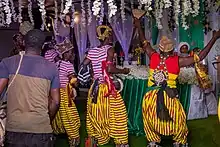
Jera is a traditional dance and music of the Dagbamba people in Northern Ghana. It has a long history dating back to the Kparibas in Dagbon, who originally performed it as a religious ritual before and after hunting expeditions. Despite its origins, Jara is now enjoyed by many Dagbamba villages on a variety of occasions, including festivals, funerals, and for leisure. One of the unique aspects of Jara is that it is still performed in traditional religious costume, despite its evolution and widespread performance on diverse social occasions. This adds an element of cultural significance and respect to the dance, honoring its roots and the history of the Dagbamba people.
Jara is a beloved and respected tradition in Northern Ghana, bringing joy, peace, and a sense of community to those who participate and witness it. Its rhythmic beats and graceful movements have stood the test of time, and it is sure to continue to be enjoyed for generations to come.
Baamaaya
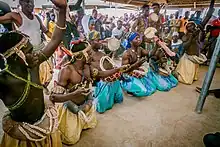
Bamaya is a popular dance in the Northern Region of Ghana, often performed at public events and functions. It is typically performed by men dressed in feminine attire, accompanied by a lead dancer, other dancers, and drummers who also sing as a chorus. The dance is characterized by swift footwork and twisting of the waist, and the dancers wear beads and cymbal bells around their waists and chins that make noise as they move. The dance is accompanied by a chorus song and the sound of drums and flutes, which dictate the tempo and movement of the dance. The leader of the group communicates the movements to the rest of the dancers, and at the end of the performance, each dancer has the opportunity to showcase their individual skills. The word "Bamaya" means "the river or valley is wet" in Dagbani.
Jina
This is religious and spiritual dance practised by the Jinwarba of Dagbon. It is often performed at night with bonfires.
Nagbegu
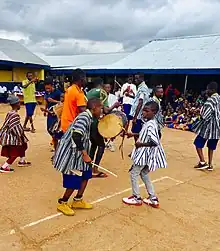
This it one of the famous solo dances in Dagbon performed by both males and females.
Nakoha Waa or Dance of the Butchers
Nakoha waa is a dance that originated among the butchers or Nakohanima of Dagomba society. The butchers dance were incorporated into Dagomba culture by Naa Dimani and have their own patrilineage, similar to that of the drummers or Lunsi. The Nakoha waa dance is a unique reflecting the important role that butchers have played in the history and traditions of this society.
Dikali or Macheli Waa or Dance of the Blacksmiths
Dikala is the music of the blacksmiths or Machelnima. The blacksmiths were incorporated into Dagomba society by Naa Luro. When Naa Luro wanted to retrieve the body of Naa Darizhagu, but had to cross a river to reach it. The blacksmiths had to be summoned to fashion tools for the woodworkers to make a bridge. The drum language for Dikala says “if you refuse a chief you will be killed,” which is a reference to the fact that the blacksmith family was originally reluctant to be part of the royal court.
Natural resources
Renewable resource
Dagbon has a rich flora and fauna. Trees such as shea, mango, baobab, kapok, teak, mahogany, and neem grow abundantly. The land supports cultivation of crops such as maize, rice, guinea corn, yam, millet, sweet potato, soybean, groundnut, Bambara beans, cassava, watermelon, and many others.
Flora
Trees:
- Adansonia digitata
- Afzelia africana
- Anogeissus leiocarpus
- Afraegle paniculata
- Burkea africana
- Butyrospermum paradoxum
- Cassia sieberana
- Celastrus senegalensis
- Combretum ghasalense
- Detarium microcarpum
- Grewia lasiodiscus
- Grewia mollis
- Lannea acida
- Maytenus senegalensis
- Piliostigma thonningii
- Pterocarpus erinaceus
- Sterculia setigera
- Tamarindus indica
- Terminalia spp., including T. avicennioides
- Ximenia americana
Shrubs:
- Diospyros mespiliformis
- Feretia apodanthera
- Flueggea virosa
- Tinnsea spp.
- Urginea spp.
Herbaceous plants:
- Abutilon ramosum
- Aneilema umbrosum
- Atylosia scarabaeoides
- Blepharis maderaspatensis
- Desmodium velutinum
- Mariscus alternifolius
- Ruellia
- Sida urens
- Triumfetta pentandra
- Wissadula amplissima
Grasslands:
- Andropogon spp., including Andropogon gayanus var. squamulatus (a tall grass)
- Brachiaria spp.
- Loudetiopsis kerstingii
Foods and diet of Dagbon
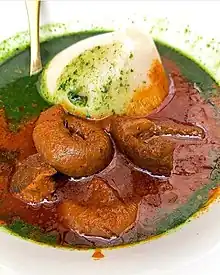
.jpg.webp)
The kingdom has a diverse selection of foods. Common foods are Sa-am (Tuozaafi), Sakoro (pounded yam), Tuya (rice and beans), Tubani, Gablee, wasawasa, yaankahanda, yaanmonda, yaankikalli, and others.
Vegetarian foods of Dagbon
Traditional vegetarian foods in Dagbon include Tuubaani, Gablee, wasawasa, yaankahanda, yaanmonda, Nyombeeka, Gora, etc.

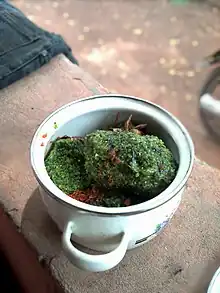
Breakfast in Dagbon
Breakfast is taken in the morning just after sunrise. Traditional breakfast is made of koko or kukuaɣli (porridge) made from either of maize, millet, guinea or a mixture of flours.
Types of porridge prepared in Dagbon
- Za koko (made from millet)
- Chi koko (made from guinea corn)
- Koko Talli (made from maize or millet or guinea corn)
- kukuaɣ nyina (any porridge with sizeable, chewable soft maize or millet)
- Zimbeɣu (porridge whose floor is made from mixtures of floor from maize, beans, millet, soybeans and others)
- Zimbuli (porridge from unsmoothened floor)
- List of rulers of the Kingdom of Dagbon
- Adibo dali
- Dagbani language
- Fire Festival In Dagbon
- Damba festival
- Notable Dagombas
References
- "Ghana Population 2019".
- MacGaffey, Wyatt (2004-01-01). "Earth Shrines and the Politics of Memory in Dagbon". Ghana Studies. 7 (1): 11–24. doi:10.3368/gs.7.1.11. ISSN 1536-5514.
- "June 1: First Centralized States Formed in the Savanna (Mamprugu, Dagbon, and Nanumba)". Edward A. Ulzen Memorial Foundation. 2017-06-01. Retrieved 2023-10-21.
- Mireri, Julian (2022-04-15). "Mole-Dagbon tribe: history, food, dance, languages, weapons, facts". Yen.com.gh - Ghana news. Retrieved 2023-10-21.
- "Makro Online Site | Makro South Africa | Never Miss a Deal. Get the Best Deals". www.makro.co.za. Retrieved 2023-10-21.
- Massing, Andreas W. (2004-12-20). "Baghayogho". Cahiers d’études africaines. 44 (176): 887–922. doi:10.4000/etudesafricaines.4850. ISSN 0008-0055.
- "CONFERENCE OF DAGBAMBA (DAGOMBA) CHIEFS" (PDF).
- "POLITICS, CHIEFTAINCY AND CUSTOMARY LAW IN GHANA" (PDF).
- "Female Chiefs in Dagbon Traditional Area: Role and Challenges in the Northern Region of Ghana" (PDF). International Journal of Sociology and Anthropology Research.
- Mohammed, Yakubu; Alhassan, Eliasu; Sayibu, Mahama Seth (2022). "Female Chiefs in Dagbon Traditional Area: Role and Challenges in the Northern Region of Ghana" (PDF). International Journal of Sociology and Anthropology Research. 10 (2): 57–81. ISSN 2059-1209.
- "Role of Female Chiefs in Dagbon Traditional Area". Art + Feminism. Retrieved 2023-09-18.
- "Female Chiefs in Dagbon; Gundo Naa holds their authority and influence". Sanatu Zambang. 2020-01-14. Retrieved 2023-09-18.
- "January 17, 1997: Ghana's first woman minister, Mrs Susanna Al-Hassan passes away". Edward A. Ulzen Memorial Foundation. 2018-01-17. Retrieved 2023-09-18.
- "Meet Susan Alhassan, the first Ghanaian woman to be appointed minister". GhanaWeb. 2023-03-05. Retrieved 2023-09-18.
- "Meet Susanna Al-Hassan, Africa's first female cabinet minister". www.myinfo.com.gh. 2023-03-04. Retrieved 2023-09-18.
- "January 17, 1997: Ghana's first woman minister, Mrs Susanna Al-Hassan passes away". Edward A. Ulzen Memorial Foundation. 2018-01-17. Retrieved 2023-09-18.
- "Yennenga: Ancestor of Burkina Faso's Mossi people – DW – 05/12/2021". dw.com. Retrieved 2023-09-18.
- "YENENGA, The Dagomba Princess". africaaccessreview.org. Retrieved 2023-09-18.
- "Princess Yennenga | Mother of the Mossi". On The Shoulders of Giants. Retrieved 2023-09-18.
- History, The African (2022-04-08). "Kingdom of Dagbon: founded in Ghana by the Red Hunter Tohazee in 11th Century". The African History. Retrieved 2023-10-22.
- Napari, Faida (2018-04-24). "THE STORY OF RED HUNTER (TOHAZIE)". Medium. Retrieved 2023-10-22.
- Wilks, Ivor (1965). "A Note on the Early Spread of Islam in Dagomba". Transactions of the Historical Society of Ghana. 8: 87–98. ISSN 0855-3246.
- Afua Hirsch (July 5, 2012). "Ghana's rival Dagbon royals risk pulling the country apart". The Guardian. Retrieved 4 January 2014.
- GhanaWeb (May 7, 2006). "Kufuor pays tribute to late Ya-Na". Ghana News Agency. Retrieved 4 January 2014.
- "Historic! Yendi goes agog as new Yaa Naa is outdoored today". www.myjoyonline.com. Retrieved 2019-11-18.
- "dagomba | Just another sites.tufts.edu site". Retrieved 2023-03-11.
- "Oral History in Dagbon: The Role of the Lunsi in Traditional African Society | Center for Advanced Study". cas.illinois.edu. Retrieved 2023-03-11.
- MacGaffey, Wyatt (2013-01-01). "Drum Chant and the Political Uses of Tradition". Chiefs, Priests, and Praise-singers: History, Politics, and Land Ownership in Northern Ghana. University of Virginia Press. ISBN 9780813933863.
- "Naa Gbewaa children". www.adrummerstestament.com. Retrieved 2023-05-21.
- "The History Of Mole Dagbon State • Dagbon Kingdom: Your Gateway to the Best of Culture, History & Tourism". 2021-09-04. Retrieved 2023-05-21.
- Danver, Steven L. (2015-03-10). Native Peoples of the World: An Encyclopedia of Groups, Cultures and Contemporary Issues. Routledge. p. 25. ISBN 9781317464006.
- ouédraogo, jean (2011-01-01), Akyeampong, Emmanuel K.; Gates, Henry Louis (eds.), "Yennenga", Dictionary of African Biography, Oxford University Press, doi:10.1093/acref/9780195382075.001.0001, ISBN 978-0-19-538207-5, retrieved 2023-05-21
- "African Books Collective: Yennenga: The Dagomba Princess". www.africanbookscollective.com. Retrieved 2023-05-21.
- admin (2019-02-16). "YENENGA, The Dagomba Princess". Retrieved 2023-05-21.
- "Bouna | African kingdom | Britannica". www.britannica.com. Retrieved 2023-05-21.
- Lentz, Carola (November 1994). "A Dagara Rebellion against Dagomba Rule? Contested Stories of Origin in North-Western Ghana". The Journal of African History. 35 (3): 457–492. doi:10.1017/S0021853700026797. ISSN 1469-5138. S2CID 161419446.
- "SCIENCE AND TECHNOLOGY IN 18TH CENTURY MOLIYILI (DAGOMBA) AND THE TIMBUKTU INTELLECTUAL TRADITION".
- "Remnants of 'Adibo dali' (1896) and the Plunder of Yendi in German Museums".
- Kinney, Sylvia (1970). "Drummers in Dagbon: The Role of the Drummer in the Damba Festival". Ethnomusicology. 14 (2): 258–265. doi:10.2307/849800. ISSN 0014-1836.
- "Moliyili: Golden Age Of Dagbon Kingdom". 2023-05-11. Retrieved 2023-09-21.
- "Oral History in Dagbon: The Role of the Lunsi in Traditional African Society | Center for Advanced Study". cas.illinois.edu. Retrieved 2023-09-21.
- "Dagomba Dance Drumming". Retrieved 2023-09-21.
- Abdallah, Z. Z. (2010). "The Lunsi (Drummers) of Dagbon: Tradition and Change". Research Review of the Institute of African Studies. doi:10.4314/rrias.v26i3.65942. ISSN 0855-4412.
- "1-11: Respect of Drumming". www.adrummerstestament.com. Retrieved 2023-09-21.
- "Drums of the Dagomba". www.nadabrahma.org. Retrieved 2023-09-21.
- "Decolonizing Our Library System: The Living Librarians (Baansi) of Dagbon, Northern Ghana".
- Letter from Hans Gruner to August Köhler, 4 Nov. 1896, German Federal Archives, BArch R 1001/4391, p. 76.
- Appiah, Anthony; Gates, Henry Louis (2010-01-01). Encyclopedia of Africa. Oxford University Press. p. 336. ISBN 9780195337709.
- Letter from Köhler to Foreign Office, 31 Mar. 1900, German Federal Archives, R 150/90, 159-160.
- Letter from Rigler to Köhler, 13. Apr. 1900, German Federal Archives, BArch R 1001/3762, p. 70.
- Tamakloe, Emmanuel F (1931). A brief history of the Dagbamba people. Accra: Gov. Print. Off. OCLC 630490339.
- Trierenberg, Georg (2018). Togo die Aufrichtung der deutschen Schutzherrschaft und die Erschließung des Landes (in German). OCLC 1030535458.
- Sebald, Peter (2013). Die deutsche Kolonie Togo 1884-1914: Auswirkungen einer Fremdherrschaft (in German). Ch. Links Verlag. ISBN 978-3-86153-693-2. OCLC 854555895.
- "Ghana, A living History". 1960.
- "The Legislation Providing for the Grant of Independence to Ghana". Journal of African Law. 1 (2): 99–112. 1957. doi:10.1017/S0021855300000176. ISSN 0021-8553. JSTOR 745294. S2CID 249895708.
- Danver, Steven L. (2015-03-10). Native Peoples of the World: An Encyclopedia of Groups, Cultures and Contemporary Issues. Routledge. p. 26. ISBN 9781317464006.
- "Ghana king's burial ends long feud". news.bbc.co.uk. 13 April 2006. Retrieved 2017-03-26.
- Awedoba, A. K. (2010-01-01). An Ethnographic Study of Northern Ghanaian Conflicts: Towards a Sustainable Peace : Key Aspects of Past, Present and Impending Conflicts in Northern Ghana and the Mechanisms for Their Address. African Books Collective. p. 205. ISBN 9789988647384.
- "Ya-Na Yakubu Andani II was killed in a war - Abudus - BusinessGhana News | General". www.businessghana.com. Retrieved 2017-03-26.
- "Savelugu Naa; Abubakari Mahama chosen as new Yaa-Naa". Citi Newsroom. 2019-01-18. Retrieved 2019-01-26.
- Haas, Karl J. "MUSIC, MASCULINITY, AND TRADITION: A MUSICAL ETHNOGRAPHY OF DAGBAMBA WARRIORS IN TAMALE, GHANA".
{{cite journal}}: Cite journal requires|journal=(help) - Stuffelbeam, Katharine; Fuseina, Wumbei (2012). "Performing Advocacy: Women's Music and Dance in Dagbon, Northern Ghana". African Music. 9 (2): 154–169. ISSN 0065-4019.
- "1-18: Baamaaya and Other Dances". www.adrummerstestament.com. Retrieved 2023-10-21.
- "Ghana Integrated Iron and Steel Development Corporation assures Dagbon of investors to kick-start mining at Shiani - MyJoyOnline". www.myjoyonline.com. 2021-11-21. Retrieved 2023-10-21.
- "Over 1.7bn tonnes of iron ore discovered in Tatale/Sanguli District". Graphic Online. Retrieved 2023-01-08.
- "Dagbon: Iron ore mine coming to Sheini – Akufo-Addo". www.classfmonline.com. 2019-01-25. Retrieved 2023-10-21.